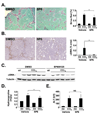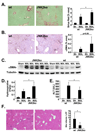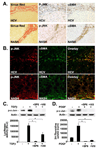Modulation of hepatic fibrosis by c-Jun-N-terminal kinase inhibition
- PMID: 19782079
- PMCID: PMC2988578
- DOI: 10.1053/j.gastro.2009.09.015
Modulation of hepatic fibrosis by c-Jun-N-terminal kinase inhibition
Abstract
Background & aims: c-Jun N-terminal kinase (JNK) is activated by multiple profibrogenic mediators; JNK activation occurs during toxic, metabolic, and autoimmune liver injury. However, its role in hepatic fibrogenesis is unknown.
Methods: JNK phosphorylation was detected by immunoblot analysis and confocal immunofluorescent microscopy in fibrotic livers from mice after bile duct ligation (BDL) or CCl(4) administration and in liver samples from patients with chronic hepatitis C and non-alcoholic steatohepatitis. Fibrogenesis was investigated in mice given the JNK inhibitor SP600125 and in JNK1- and JNK2-deficient mice following BDL or CCl(4) administration. Hepatic stellate cell (HSC) activation was determined in primary mouse HSCs incubated with pan-JNK inhibitors SP600125 and VIII.
Results: JNK phosphorylation was strongly increased in livers of mice following BDL or CCl(4) administration as well as in human fibrotic livers, occurring predominantly in myofibroblasts. In vitro, pan-JNK inhibitors prevented transforming growth factor (TGF) beta-, platelet-derived growth factor-, and angiotensin II-induced murine HSC activation and decreased platelet-derived growth factor and TGF-beta signaling in human HSCs. In vivo, pan-JNK inhibition did not affect liver injury but significantly reduced fibrosis after BDL or CCl(4). JNK1-deficient mice had decreased fibrosis after BDL or CCl(4), whereas JNK2-deficient mice displayed increased fibrosis after BDL but fibrosis was not changed after CCl(4). Moreover, patients with chronic hepatitis C who displayed decreased fibrosis in response to the angiotensin receptor type 1 blocker losartan showed decreased JNK phosphorylation.
Conclusions: JNK is involved in HSC activation and fibrogenesis and represents a potential target for antifibrotic treatment approaches.
Copyright 2010 AGA Institute. Published by Elsevier Inc. All rights reserved.
Conflict of interest statement
Disclosures: No conflicting interests exist.
Figures







Similar articles
-
Inhibition of PDGF, TGF-β, and Abl signaling and reduction of liver fibrosis by the small molecule Bcr-Abl tyrosine kinase antagonist Nilotinib.J Hepatol. 2011 Sep;55(3):612-625. doi: 10.1016/j.jhep.2010.11.035. Epub 2011 Jan 18. J Hepatol. 2011. PMID: 21251937
-
Combined Activities of JNK1 and JNK2 in Hepatocytes Protect Against Toxic Liver Injury.Gastroenterology. 2016 Apr;150(4):968-81. doi: 10.1053/j.gastro.2015.12.019. Epub 2015 Dec 19. Gastroenterology. 2016. PMID: 26708719 Free PMC article.
-
Physalin D attenuates hepatic stellate cell activation and liver fibrosis by blocking TGF-β/Smad and YAP signaling.Phytomedicine. 2020 Nov;78:153294. doi: 10.1016/j.phymed.2020.153294. Epub 2020 Jul 28. Phytomedicine. 2020. PMID: 32771890
-
Hepatic stellate cells as key target in liver fibrosis.Adv Drug Deliv Rev. 2017 Nov 1;121:27-42. doi: 10.1016/j.addr.2017.05.007. Epub 2017 May 12. Adv Drug Deliv Rev. 2017. PMID: 28506744 Free PMC article. Review.
-
Current and future anti-fibrotic therapies for chronic liver disease.Clin Liver Dis. 2008 Nov;12(4):939-62, xi. doi: 10.1016/j.cld.2008.07.011. Clin Liver Dis. 2008. PMID: 18984475 Free PMC article. Review.
Cited by
-
3,3'-Diindolylmethane ameliorates experimental hepatic fibrosis via inhibiting miR-21 expression.Br J Pharmacol. 2013 Oct;170(3):649-60. doi: 10.1111/bph.12323. Br J Pharmacol. 2013. PMID: 23902531 Free PMC article.
-
Posttranslational modification of vesicular stomatitis virus glycoprotein, but not JNK inhibition, is the antiviral mechanism of SP600125.J Virol. 2012 May;86(9):4844-55. doi: 10.1128/JVI.06649-11. Epub 2012 Feb 15. J Virol. 2012. PMID: 22345438 Free PMC article.
-
A liver full of JNK: signaling in regulation of cell function and disease pathogenesis, and clinical approaches.Gastroenterology. 2012 Aug;143(2):307-20. doi: 10.1053/j.gastro.2012.06.004. Epub 2012 Jun 13. Gastroenterology. 2012. PMID: 22705006 Free PMC article. Review.
-
Cytokines in adipose-derived mesenchymal stem cells promote the healing of liver disease.World J Stem Cells. 2018 Nov 26;10(11):146-159. doi: 10.4252/wjsc.v10.i11.146. World J Stem Cells. 2018. PMID: 30631390 Free PMC article. Review.
-
The autoregulatory feedback loop of microRNA-21/programmed cell death protein 4/activation protein-1 (MiR-21/PDCD4/AP-1) as a driving force for hepatic fibrosis development.J Biol Chem. 2013 Dec 27;288(52):37082-93. doi: 10.1074/jbc.M113.517953. Epub 2013 Nov 6. J Biol Chem. 2013. PMID: 24196965 Free PMC article. Clinical Trial.
References
-
- Minden A, Karin M. Regulation and function of the JNK subgroup of MAP kinases. Biochim Biophys Acta. 1997;1333:F85–F104. - PubMed
-
- Weston CR, Davis RJ. The JNK signal transduction pathway. Curr Opin Cell Biol. 2007;19:142–149. - PubMed
-
- Hibi M, Lin A, Smeal T, Minden A, Karin M. Identification of an oncoprotein- and UV-responsive protein kinase that binds and potentiates the c-Jun activation domain. Genes Dev. 1993;7:2135–2148. - PubMed
Publication types
MeSH terms
Substances
Grants and funding
LinkOut - more resources
Full Text Sources
Other Literature Sources
Medical
Research Materials
Miscellaneous

